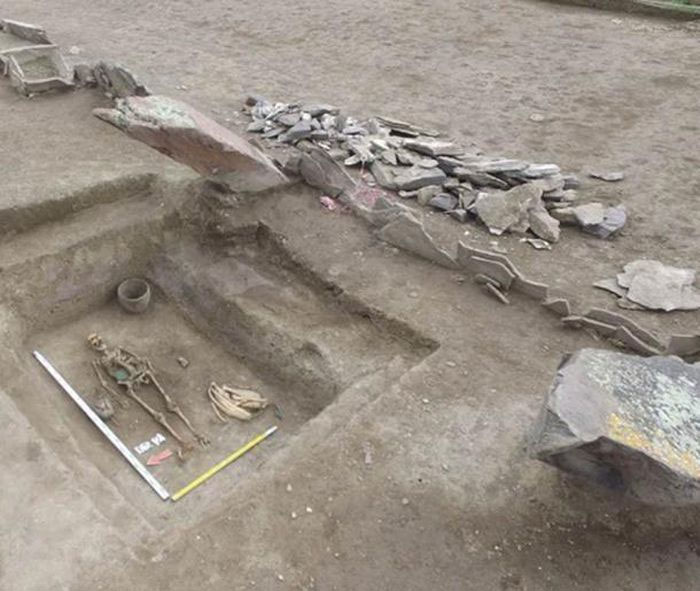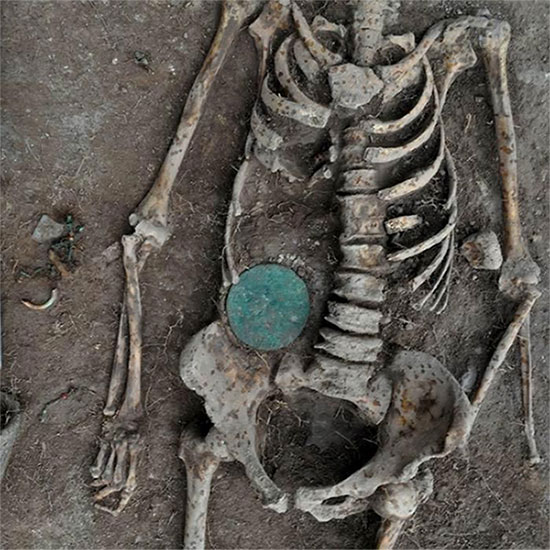Ancient graves provide essential insights into a culture across historical timelines and specific geographical territories. Some of these ancient customs and prehistoric practices have been preserved by modern humans, reflected in various contemporary cultures and religions through cremation and burial. Recently, a unique amulet from the Bronze Age made from an unusual piece of human bone was discovered in a grave in southern Siberia, serving as a significant example.
Tagar Culture Grave and the Human Bone Amulet

The grave of a woman from the Tagar culture, where the human bone amulet was found beside her on the left side of this image, just above the pottery.
The fertile Minusinsk Basin in Siberia is home to countless historical cultures, most notably the Tagars of the Siberian steppes. In 2020, a cemetery known as Kazanovka 1 (Late Bronze Age to Early Iron Age) was excavated.
The Tagars were a Bronze Age culture that thrived from the 8th to the 2nd century BCE in southern Siberia, situated between the Karasuk and Tashtyk cultures. It is widely recognized as one of the largest centers of copper smelting in ancient Eurasia, contemporaneous with the Scythians in Crimea and the northern Black Sea region.
Hundreds of burial mounds of the Tagars have been preserved and documented. From these earthen mounds, thousands of exquisitely preserved bronze artifacts have been excavated and exhibited at the Khakass National Museum in Abakan.
In mound number 15, there are two enclosures, with the main enclosure containing four graves with three adults in the center of the mound. The mourners dug a pit measuring 2.5 x 4.45 meters (8.2 x 14.5 feet), with the perimeter decorated with small stone slabs, and a horse skull placed on the grave cover. This object of curiosity and amazement was positioned with a woman laid on her back facing west.
She was buried with a pottery vessel, a bronze mirror, a leather pouch, bronze plates and pins, pieces of meat, and the remains of a calf and a sheep (a continuation of the Karashuk tradition), along with a bronze amulet placed next to her right elbow. At the center, the amulet contained a piece of human bone and a silk fabric pouch (now torn), while the top was adorned with bronze beads and tubular carnelian beads, and the bottom featured a hanging wild boar tusk!
Interestingly, other burial sites in the region have reported findings of bead chains, animal bones, tusks from wild boars or musk deer, and bird claws, indicating that such items are not rare. Similar amulets have also been found in the basin, and they are almost always associated with female burials.
The human bone is an anomaly, and archaeologists suspect it served some magical or ritualistic purpose. This could also be an example of secondary burial, meaning after the initial burial of the remains and grave goods in the culture, the amulet may have been placed beside her later.

The bone amulet beside the right side of the woman (left side of the photo), where one piece is human bone, making this grave a unique anomaly among all other early Tagar graves.
Global Burial Practices and Issues with Tagar Materials
While mummification is a careful method of preserving the deceased as they transition to the afterlife, cremation is a way of reducing the body to ashes (ashes hold spiritual and religious significance in many cultures).
According to a report from Ancient Origins earlier this month, the practice of mummification dates back at least 8,000 years, while cremation has been practiced for at least 17,000 years. Secondary burials are those where the remains of the deceased are manipulated, often linked to prehistoric West Asian cultures.
The deceased are typically accompanied by belongings to ensure a smooth transition to the afterlife, with valuable material goods “allowed” into the higher realm after this world. These funerary items are also a way to mark the social status of the deceased in their current life, and for archaeologists and historians, they have proven to be a significant marker for understanding the burial customs of our ancestors. The best-preserved graves date back to the Upper Paleolithic period, approximately 40,000 to 12,000 years ago!
All of the aforementioned practices are accompanied by various rituals and ceremonies that differ among religions worldwide. Today, it is common for a mediator or shaman to conduct these rituals in the presence of family and loved ones. In ancient Egypt, guidebooks were written to preserve the ritual details of these events for future generations who would follow similar steps when their time came.
Although this is one of the most extensively studied ancient Siberian cultures, the ethnographic burial customs of the Tagars remain largely unknown, primarily due to tomb robbing, which poses a significant threat to archaeological reconstruction.
The Minusinsk Basin in Siberia, Russia, is not conducive to the preservation of organic materials and other deposits, making historical reconstruction more challenging. Ultimately, the early stages of tomb explorations were marked by poor-quality analyses and documentation, leading to the loss of invaluable artifacts and records.


















































